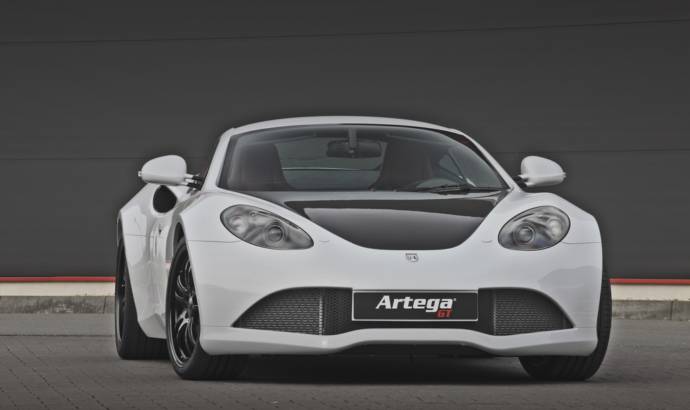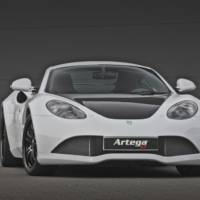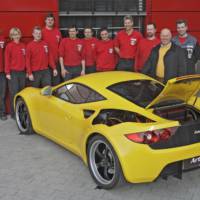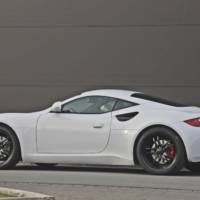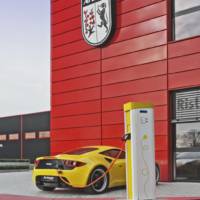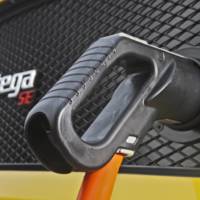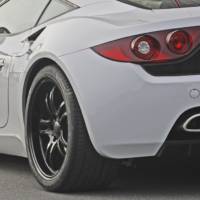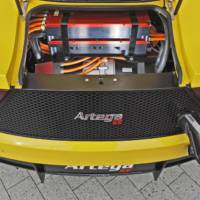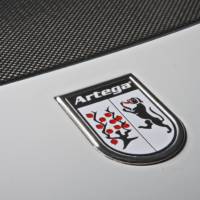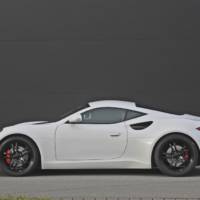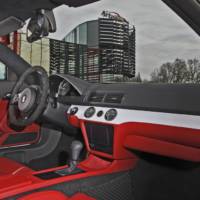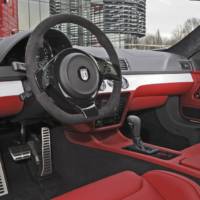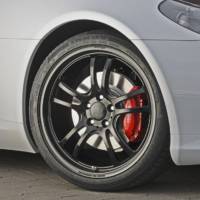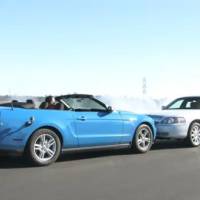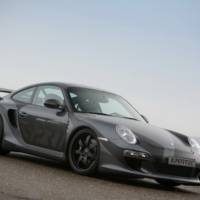German based automaker Artega has presented an electric sports car prototype at this year’s 81st edition Geneva Motor Show called the Artega SE, which looks identical to the GT model, except this time the powertrain is composed of batteries and two electric motors placed on the rear axle.
These two independent electric motors enable the Artega SE to develop a total of 380 HP (280 kW), which in terms of performance means a top speed of 250 Km/h and a 0 to 100 Km/h acceleration time of 4.3 seconds (0.5 seconds quicker than the Artega GT).
The Artega SE’s water-cooled lithium-polymer battery pack produces a total of 37 kWh and a nominal
voltage of 350 V, while its total weight is 310 kg. The whole pack is composed from 16 battery modules, it takes around 90 minuts to fully regain its power, and enables the Agera SE to have a 300 Km autonomy.
1. Artega at the 2011 Geneva Motor Show
World premier of the electrically powered Artega SE
At the 81st Geneva Motor Show from 1-13 March 2011, Artega Automobil GmbH & Co. KG will introduce an electric version of its mid-engine sports car. “Our aim is to combine environmental responsibility with the passion for automobiles,” said Artega chief executive Peter Müller.
With this forward-looking project, the company headquartered in Delbrück once again demonstrates the benefits and strengths of its manufacturing plant. Technical expertise and quick decision-making processes have enabled the company to implement a completely new drive concept in a very short period of time. Artega has also cooperated with the Fraunhofer Institute, one of the most competent development partners in the automotive sector. The research organization bought two Artega vehicles more than a year ago to test their feasibility as electrically powered cars.
The new electric model will be announced at a press conference at 1 p.m. on 1 March 2011 at the Artega stand in Hall 4, exhibit stand #4231. Peter Müller will report on the company’s progress since its appearance at last year’s Geneva Motor Show and will introduce the newly established company Artega Automobile Switzerland AG.
Following Mr. Muller’s presentation, Dr. Wolfgang Ziebart will elucidate the technical features of the Artega SE. The initials stand for “Sport Electric.” The initiator of the E-mobility project is convinced of the advantages of electrically powered sports cars. “Sports car drivers usually have a very dynamic driving style, with frequent acceleration and braking, which is very energy inefficient. But electric cars recuperate the energy lost through braking and return it to the battery. In addition, unlike combustion engine vehicles, electric vehicles convert the full extent of the engine torque immediately, which makes driving them a completely new, very dynamic experience.”
The manufacturing plant in Delbrück will shortly make it possible for people to experience these advantages first-hand. The vehicle is expected to be introduced in the late summer of 2011, prior to the IAA in Frankfurt. If the reaction is as positive as expected, a concerted effort will be made immediately to prepare the car for mass production. It could be on the market by April 2012.
Artega®GT with serial carbon fibre hood, EU5 and individual configuration
A front hood made of carbon fiber reinforced plastic and EU5 are standard on the Artega®GT. The model shown at the company’s Geneva exhibit also underscores the benefits of the in-house manufacturing concept, which offers the best potential for creating extraordinary, exclusive vehicles. For starters, there are no limits to the colors available. The Geneva Motor Show version, for example, is in Suzuka grey metallic with matching upholstery in two colors: the top of the instrument panel and the door trim moldings are upholstered in black leather, while the rest of the upholstery is red leather. Other sporty features include the air intakes and the hood with a visible carbon structure, which provide another clear indication of the uncompromising lightweight construction of the GT. The black wheels also underscore the sports car’s high performance.
2. The Artega SE
High performance with zero emissions
Two electric motors on the rear axle with a total output of 280 kW (380 horsepower) give the car its powerful thrust. The two engines operate independently, with each driving one of the rear wheels. The Artega SE accelerates from zero to 100 km/h in just 4.3 seconds (4.8 seconds with a combustion engine). Unlike the combustion engine, the electric engines transmit their power linearly and immediately, with no delay. The maximum velocity is well over 250 km/h. The entire drive train weight just 150 kilograms. The degree of efficiency is extremely high, namely more than 90%.
State-of-the-art battery technology
A total of 16 tried-and-tested battery modules with lithium ion polymer cells are built into the Artega SE. Each of these modules contains 12 battery cells, and they operate for the most part autonomously. Twelve modules are located in the rear of the vehicle and four in the front. All of the batteries are water-cooled and produce a total of 37 kilowatt/hours and a nominal voltage of 350 V. The total weight of the battery system is 310 kg.
According to the New European Driving Cycle standard, the Artega SE has a range of 300 kilometers; under normal driving conditions it can comfortably achieve 200 km. The batteries can be recharged using conventional household electricity with the help of a plug in the rear of the vehicle. The recharging time can be considerably reduced when park-and-ride stations or special parking lots with recharging facilities are used. The depleted batteries can be fully recharged in just 90 minutes.
The Artega design promises optimal results with low added weight
The mid-engine concept and the rear-attached subframe for the drive unit are excellently suited for use with an electric motor. The axle distribution of 57% in the rear and 43% in the front is identical to that of the Artega®GT with a combustion engine. Its uncompromising lightweight construction gives it a total weight according to EU standards of just 1285 kilograms – a decisive advantage over its competition. The Artega SE weighs in at 1400 kg, just about 10% more than the GT version. That means the handling and braking performance will be comparable to those of the Artega®GT, which received outstanding reviews in the trade press. The entire vehicle with brakes and damping has the appropriate dimensions to accommodate the added power of 59 kW (80 horsepower) and resulting improved performance of the electric version.
Innovative recuperation settings
Using the toggle switches on the steering wheel, the driver can adjust the recuperation rate when he removes his foot from the accelerator. The settings are variable from about 75 kW to zero recuperation, a level referred to as “sailing.” This allows the driver to modify the characteristics of the acceleration pedal to suit his own wishes or the respective driving conditions.
The instrument cluster has been redesigned with combined analog/digital displays for speed, range, battery level and energy flow.
Sufficient production capacity in Delbrück
With 4000 square meters of production space, the plant in Delbrück is easily capable of manufacturing a second version of the sports car. It is possible to make up to 500 vehicles per year without compromising the extremely high quality standards the company has set for itself.
There is a market for high-quality electric cars
The McKinsey consulting company has conducted extensive research into the market for electric cars and published the results in its quarterly report in February 2011. The report said the potential customer demand for all-electric and hybrid vehicles with electric engines is currently as high as 16% in major metropolitan areas such as New York, Paris and Shanghai. Moreover, interest in buying such vehicles was independent of the availability of charging stations – and also independent of state subsidies or incentives.
The target groups interested in electric cars can be categorized as public institutions, companies that want to make a contribution to the environment and the so-called “early adopters,” customers found primarily in large urban areas who are generally willing to spend more for technological innovations. As a rule, this target group owns at least one additional car, so any limitations in the potential range of electric cars would play a subordinate role.
Thanks to careful calculation, Artega is able to offer the exclusive SE at the attractive price of 150,000 euros. This price lies between that of existing first-generation sports cars and the anticipated price of mass-produced electric sports cars that have been announced by the major manufacturers.
The vehicle is one of a kind
The Artega SE is sure to enhance social acceptance of the sports cars of tomorrow. After all, it is a fine example of German engineering and will be manufactured “by hand” to meet the customer’s individual wishes – just like its counterpart with a combustion engine, the Artega GT. The new German sports car from Delbrück in North Rhine-Westphalia is a one-of-a-kind vehicle. The small-scale manufacturing process makes it possible to incorporate numerous new technologies. The Artega – whether with a combustion engine or an electric motor – is a genuine innovation and sets itself apart from other vehicles.
3. Overview of the Artega®GT
Unmistakable design
The renowned designer Henrik Fisker, who created the BMW Z8 and the Aston Martin Vantage, among other models, has created an unmistakable design with the length of a compact car (4.015 meters) and the width of a luxury limousine (1.88 meters). It is both powerful and appealing.
Impressive performance with low consumption figures thanks to uncompromising lightweight construction
A combination of materials familiar from racing sports, namely an aluminum space frame, high-strength steel and alloys reinforced with carbon fiber, give the Artega®GT an unloaded weight of just 1285 kilograms in spite of the extensive standard equipment built into the vehicle. This makes the sports car one of the lightest in its class. The V6 engine has a cubic capacity of 3597 cubic centimeters and produces 300 horsepower (220 kW), resulting in a performance ratio of 4.28 kilograms per HP. The low weight-to-performance ratio and the state-of-the-art drive train ensure extreme agility and impressive driving performance. The car accelerates from 0 to 100 km/h in just 4.8 seconds. Its highest speed is 270 kilometers per h our.
The midship concept and direct steering optimize driving pleasure. Average consumption according to EURO 5 standards is just 9.2 liters per 100 kilometers.
The ultimate in exclusivity
Artega has built a factory that produces individual vehicles with great care. One of its trademarks is the high percentage of parts produced in-house, including the chassis, wheel suspension, engine periphery and the fueling and exhaust systems. Each individual vehicle is put together in traditional handwork to meet the specifications of the customer. Highly skilled workers assemble the technical components, the body and the interior.
The Artega will always remain an exclusive product. The factory in Delbrück will manufacture no more than 500 sports cars per year.
4. The Artega®GT in detail
The Artega®GT features many technological highlights. A combination of materials familiar from racing sports results in uncompromising lightweight construction. The aluminum spaceframe is made of high-strength steel combined with carbon fiber-reinforced alloys. The modular construction ensures easy maintenance. The structure was optimized following extensive crash tests. The aerodynamic qualities are sophisticated, and the rear diffuser ensures optimal downforce. The forceful drive train made by a major manufacturer and the double-clutch transmission guarantee dynamic driving and the best reliability possible. The well-balanced vehicle design is conducive to excellent braking performance and makes driving a joy.
The aluminum spaceframe weighs less than 100 kilograms
To ensure the highest possible quality, the manufacturing process of the Artega®GT adheres to standards applicable for the airline and aerospace industries. The aluminum space frame was developed by the company’s in-house construction department in Delbrück. The modular construction is lightweight and extremely rigid.
The space frame is manufactured entirely at the new automotive plant in Westphalia. Extruded aluminum components created especially for the Artega are MIG welded together to form a high-tensile frame that features optimal strength and torsional stiffness. All work steps are carried out in-house, and in adherence with the strictest aerospace standards (DIN 29595).
For the subsequent processing of the sophisticated aluminum alloy, Artega also adheres to its own strict quality standards. All welding is done by experts certified according to the DIN 29595 standards applicable for the aerospace industry.
Materials are selected in accordance with similarly strict criteria. The aluminum alloy (AlMgSi 0.5 T6) is resistant to salt and seawater. To underscore the long life of the spaceframe, Artega production manager Martin von der Lieth says, “You can submerge the entire frame in the ocean without incurring any damage.”
High-quality steel alloys
Another component of the lightweight construction concept is the rear module comprising a tube frame of high-tensile steel. The bracket is made of a high-strength steel alloy tested in racing sports (25CrMo4). It is surface-treated for long-lasting protection against corrosion. Prior to final assembly, the space frame chassis and the bracket for the engine and transmission are welded together in the so-called “wedding chamber.”
Undercarriage with honeycomb structure – lightweight and robust
The aluminum honeycomb structure of the Artega’s chassis is extremely rigid without being heavy. The lightweight and robust component is manufactured using a sandwiching technique perfected for airplanes. The chassis is bonded to the space frame.
Uncompromising lightweight construction with a unique outer shell
The Artega®GT is the world’s first vehicle with a body made primarily of carbon fiber-reinforced polyurethane (PUR), a material made in collaboration with BASF subsidiary Elastogran. The combination of various PUR materials with outstanding mechanical characteristics considerably reduces the weight of the Artega®GT and offers additional advantages in terms of cost and safety. Fenders, rear, nose and sides of the sports car are made of the carbon fiber-reinforced, micro-cellular material Elastolit, which is very robust and impact resistant, even at cold temperatures. The low thermal expansion coefficient of fiber-reinforced PUR ensures an extremely accurate fit and low heat distortion.
The quality of the lightweight material’s surface is ideal for Class A painting of free-formed parts. The car’s roof and the lid of the trunk also employ a special combination of multi-layered PUR materials that is being used here for the first time. This sandwiched material provides enhanced torsional stiffness with a considerable reduction in weight. The foam-backed hood – created using yet another new technique – also exhibits these benefits.
Crash tests – Nothing is left to chance
Germany requires extensive, cost-intensive crash tests before automobiles can be mass-produced. Artega is one of the few small-series manufacturers to conduct comprehensive crash tests so that in the event of an accident nothing is left to chance.
During the development phase of the Artega®GT, the engineers designed the car for optimal safety. So-called “load paths” were created to distribute impact force. Sophisticated techniques were employed to avoid the creation of impact nodes and junctions; where they could not be avoided altogether, these junctures were made of particularly strong materials. Potential weak points were reinforced or the impact force channeled into special energy absorbers.
The prototypes proved that in actual crashes the impact force behaved just as the theory had intended. The Artega®GT was analyzed step by step and provided with force limiters and seat belts with pretensioners, and the holding points and belt lengths were carefully calculated. Subsequently full-size front and side airbags were designed and installed. The doors were reinforced with steel for impact protection (15 CDV 6), and the roof construction was given a cage-like design, making it possible to forego the use of a B-pillar.
The Artega®GT was then once again subjected to actual crash tests to prove the suitability of the components. The result of this elaborate process was a vehicle that is not only light in weight but also very safe, with optimal torsional rigidity. In the case of an accident, intelligently arranged crash elements ensure the impact force is distributed evenly. The energy is channeled into the vehicle’s most stable component: the main frame. Energy is distributed into three sections – the transmission tunnel and the two side chassis beams – which create a “safety cell” around the driver capable of withstanding extreme force. In this regard, Artega far exceeds the conventional expectations placed on a small-series automobile manufacturer.
Sophisticated aerodynamics with rear diffuser
Technical expertise gained in motor sports and comprehensive findings from wind tunnel tests were employed in the design and construction of the Artega®GT. The underbody of the Artega®GT is fully enclosed and thus especially turbulence-free. Another special feature of the undercarriage is the rear diffuser, which creates striking effects: The entire Artega®GT functions like an upside-down airplane wing. The air underneath the vehicle’s rear moves faster, resulting in lower air pressure underneath the car that pulls the vehicle closer to the ground. This effect is called downforce or negative lift. It is as if the Artega®GT were actually being pressed downward onto the road.
Chassis suited for racing sports as well as everyday use
When it came to suspension tuning of the chassis, Artega chose an approach that is both smooth and sporty – without opting for a halfhearted compromise. Here too, the Artega®GT plays up its design advantages, namely a wide track width and large wheelbase combined with a low center of gravity. The result: The Artega takes curve after curve without creating excessive centrifugal force, staying on track even under extreme driving conditions. And with careful application of the gas pedal, slight oversteer makes the sports car a joy to drive.
These characteristics are particularly overt on the racing track, where the Artega chassis reduces roll motion to a minimum. Longitudinal and transversal forces are transferred optimally thanks to the car’s road-gripping qualities. The suspension of the Artega®GT is never “hard as a board.” The professional set-up developed in collaboration with the motor sports specialists from Bilstein guarantees maximal tracking stability and safe cornering. What’s more, thanks to the car’s optimized design, there’s no rearing up or dipping down when braking or accelerating.
All of these traits make the Artega®GT perfect for relaxed, comfortable driving. It’s a sports car for everyday use.
Artega with outstanding braking performance
In its ranking of the best results in braking tests, an internationally renowned trade publication printed an article entitled “The Best Braking Performers” and awarded the prototype of the Artega®GT second place among 450 tested vehicles. Only the Ferrari 599 GTB Fiorano had a shorter braking distance. The Porsche 911 GT3 came in third.
This was the cause for great rejoicing among the Artega team, especially because the magazine’s brake tests are considered the best in the world.
The Artega engineers credit this sensational result to three primary factors, all of which are optimally fulfilled by the Artega®GT.
First, the vehicle’s design. The optimal braking effect is achieved by a vehicle with perfectly even, 50:50 distribution of its weight to its axles. This is due to the so-called friction coefficient between the tires and the road, which is not a constant value, but which decreases as normal forces increases. Therefore the normal force of the vehicle should be distributed as evenly as possible to all four wheels when the brakes are applied. The excellent mass distribution of the Artega at rest (57 percent to the rear, 43 percent to the front), its low center of gravity and long wheelbase result in near perfect distribution of weight during full braking. Indeed, the wide tires of the Artega®GT are capable of absorbing even more braking power.
The brakes themselves are the second factor. The trade publication measured the braking distance after the tenth full brake. That means the size of the brakes and the brake cooling equipment are important, so as little heat as possible is conducted from the brake to the brake fluid. Otherwise the braking distance would increase due to steam bubbles in the brake fluid.
The tires are the third decisive factor for optimal braking. Whereby it must be pointed out that the required tire qualities must be seen in context. For example, if the tires are chosen for optimal braking performance, there may be detrimental effects on other characteristics such as driving comfort or handling on wet roads. The tires used on the Artega®GT were not chosen specifically to produce optimal braking results, but have good all-round characteristics.
Extremely lightweight forged wheels
In collaboration with the wheel rim specialists from APP Tech of Italy, one of the lightest forged wheels available with a 19-inch diameter was chosen for the GT. The goal was to combine the highest performance with sporty, elegant design while keeping weight to a minimum. APP Tech, a well-known supplier of exclusive forged wheels, produces the specially made, lightweight forged wheels offered as an option for the Artega®GT.
The forging technique enables thinner wheel walls than are possible with cast aluminum wheels, while retaining the same stability and enhanced safety reserves. This special combination is made possible because forged aluminum alloys are more stable than cast aluminum alloys. The forging technique has the added advantage of weight savings of up to 35 percent as compared with casting. Driving comfort also benefits from the reduction in unsprung mass, because the suspension, cushions and springs function better and last longer. Sporty, agile handling is one of the tangible effects. What’s more, lighter wheels not only save gas and shorten the braking distance, they also result in better cornering – all of which means improved passive safety.
Technical data of the optional wheels
Front dimensions: 8” x 19” with 235/35 tires
Rear dimensions: 10.5” x 19” with 305/30 tires
Front weight: 8.6 kg
Rear weight: 9.8 kg
Bolt circle: 5 x 112 mm
Offset: VA 43 mm, HA 45 mm
Technical data of the standard wheels
Front dimensions: 8” x 19” with 235/35 tires
Rear dimensions: 9.5” x 19” with 285/30 tires
Front weight: 9.1 kg
Rear weight: 9.7 kg
Bolt circle: 5 x 112 mm
Offset: VA 43 mm, HA 45 mm
Reliability and convenient maintenance thanks to serial production
The engine of the Artega®GT comes from the sporty R models made by Volkswagen. The powerful V-6 engine with displacement of more than 3,597 cubic centimeters produces 300 horsepower (220 kW) and can accelerate from zero to 100 km/h in just 4.8 seconds. The top speed is 270 km/h.
State-of-the-art dual-clutch transmission
The dual clutch transmission enables fully automatic gear changes with no traction interruptions. This state-of-the-art transmission concept, which has been perfected in road racing, is also known as direct shift transmission.
Sophisticated transmission electronics control the gear changes in the two gear sections and the two clutches. When shifting gears, the load-free gear section is activated with the help of the second clutch and takes over to compensate for the torque interruption in the first gear section. Once the first section has shifted gears, torque is transferred back. The entire process goes virtually unnoticed by the driver, as there is no perceptible interruption of torque. Gears can be shifted fully automatically, or manually using shift paddles on the steering wheel or the gearshift lever on the middle console.
The dual clutch transmission not only affords the fastest gear shits available in a mass-produced automobile, its automatic mode also offers a degree of comfort previously unheard of in a sports car. And thanks to optimal shifting points, it also saves fuel.
Electronics proven in mass production feature an innovative multi-functional
control unit
The vehicle electronics are based on a system procured from a major manufacturer which has undergone thorough testing.
The instrument cluster of the Artega®GT features a world premiere, namely two coaxial displays for speed and RPMs. These important displays are centrally located in the driver’s direct line of sight.
The automotive supplier Paragon provides its “integra” multi-functional control unit for the Artega®GT. As its name indicates, it integrates the controls for all components including the navigation system, climate control, radio, MP3 player, telephone, driver information and vehicle status. All parameters are controlled using a single operating panel. This pioneering system even allows the driver to change the settings for the Artega Stability Program (ASP).
The Artega has a TFT display in 640 x 480 pixel format (VGA). The operating interface with capacitive sensors and a high-gloss finish ensure ease of operation and a contemporary appearance. The Linux-based software makes it possible to retrofit additional components such as a rear-view camera.
The Mirror Pilot opens up a whole new dimension in navigation systems
The centrally located rear-view mirror of the Artega®GT is the ideal place for the driver-vehicle communication interface. The user-friendly navigation system in the mirror features a 2.2-inch TFT display with 65,000 colors. The driver can use the navigation system without taking his eyes off the road.
The system can be operated using the two buttons and rotary/push knob on the mirror itself, or by means of an infrared remote control. There are also several methods available for entering destination coordinates: You can enter the postal code or the entire address. When the navigation system is not in use, the display turns off and the entire mirror is once again available.
Top-performance racing car suitable for everyday use
The Artega®GT proves that a sports car can be fast, lightweight, and yet still well equipped. The above-mentioned crash module and the excellent brakes guarantee the safety of the driver and passengers. Unlike some “driving machines” designed for speed but not comfort, the Artega®GT features a generous interior that makes it ideally suited for everyday use.
Forward-looking environmental profile
The low power-to-weight ratio of the Artega GT gives it surprisingly efficient consumption figures and makes it environmentally future-oriented. The average consumption on the basis of the EURO 5 standard is just 9.2 liters per 100 kilometers – an outstanding figure for a sports car. This translates into potential range of more than 750 kilometers on a single tank of gas, which enhances driving comfort on long-haul trips. Environmentally friendly production processes and a high recycling quota also contribute to the favorable environmental profile of the Artega®GT.
5. Technical data for the Artega®GT
Engine V-6 injection engine in the rear
Displacement 3597 ccm
Power 220 kW (300 HP)
DIN unladen weight 1285 kg
Permissable gross weight 1495 kg
Power-to-weight ratio 4.28 kg/HP
Transmission 6-gear direct-shift transmission
Acceleration 0-100 km/h 4.8 s
Maximum speed 270 km/h
EU consumption figures (Euro 5) 9.2 l (Super Plus ROZ 98) / 100 km
CO2 emissions 220 g/km
Range 765 km
Frame Aluminum spaceframe, rear module,
grid frame made of tubular steel
Chassis Carbon fiber-reinforced synthetics
CFRP front hood
Dimensions (L x W x H) 4015 x 1882 x 1180 mm
Wheelbase 2460 mm
Luggage compartment volume 300 l
Price (standard equipment)
Artega®GT Coupé 70,504.20 EUR (net) 83.900 EUR (gross)
6. Artega Automobil GmbH & Co. KG – a company with
experienced management and a solid financial base
The new headquarters and production plant built in Dellbrück, North Rhein-Westphalia by Artega Automobil GmbH & Co. KG create optimal conditions for the serial production of the Artega®GT. Two structures in typical Artega design, with a manufacturing area covering 4000 square meters, announce the presence of the new automobile brand. The manufacturing and final assembly plant is where the vehicles are actually made, while the global marketing and customer service departments are headquartered in the adjacent Brand and Sales Center.
Founded in early 2006, Artega Automobil GmbH & Co. KG has set the goal of marketing extraordinary, fully equipped sports cars that are also perfectly suited for everyday use. To this end, the company has constructed a new automotive plant in Delbrück capable of producing up to 500 units per year. Tresalia Capital acquired 100 percent of Artega in December 2009.
Peter Müller heads the management of Artega
Peter Müller (50) took over the leadership of Artega Automobil GmbH & Co. KG on October 1, 2010. His predecessor Dr. Wolfgang Ziebart (60) has joined the company’s advisory board, which previously comprised exclusively a group of Mexican investors, and will also focus his attention on developing a new hybrid version of the company’s sports car.
Peter Müller, who holds degrees in business administration and engineering, served as COO under CEO Wolfgang Ziebert since the company was purchased by Tresalia Capital. Müller has extensive experience in the automotive industry, having worked at Porsche AG from 1985 to 1996 in a variety of positions, including head of product management and sales director for the Boxster and the new generation of 911 models. From 1996 to 1998 he was responsible for corporate marketing and communications at Webasto AG Fahrzeugtechnik. In 2001 he joined the top management of BMW AG and served as head of market, product and pricing strategy. Müller has served on the board of management of BMW Motorrad since 2002; during his time there his area of responsibility ranged from sales and marketing to development and product lines.
Dr. Wolfgang Ziebart has also spent his entire career in the automotive industry. From 1977 to 2000 he filled a variety of positions at BMW AG; most recently he served on the board of management, responsible for research and development as well as sales. Ziebart also served on the board of Continental AG (2000-2004, three years as deputy chairman) and Infineon Technologies AG (2004-2008, as chairman). He heads the board of management at Artega and continues to oversee the company as CEO.
Private investor from Mexico provides long-term perspective
The company’s robust capital base ensures the serial production of the Artega®GT. Mexican private investor Tresalia Capital stands behind the endeavor. The acquisition of Artega by Tresalia Capital brought in the necessary funds to push ahead with mass production and begin marketing the new automobile.
Tresalia Capital is refreshingly different from other private equity investors – the notorious “locusts” – who are only interested in short-term profits. Tresalia Capital is a family company that typically retains its interest in the companies it acquires for more than ten years. The company is one of the primary shareholders of the Modelo brewery (brand name “Corona”) and also invests in lifestyle companies such as the Tory Burch fashion chain.
7. The dealer network has been expanded
The first Artega®GT models came off the company’s assembly line in May 2010 and were shipped to existing dealerships and customers. The company is currently making plans to expand the dealership network, whereby the initial focus will remain on Europe.
The worldwide long-term trend toward individualization points to an expanding market for extraordinary, exclusive automobiles. Within this specific market segment, Artega sees itself not as a competitor to existing manufacturers, but as a valuable addition to the available offerings.
At the 2011 Geneva Motor Show, Artega is making its first appearance in conjunction with the Swiss importer Artega Automobile Switzerland AG. The new sales agency in Hamburg, AutoNova GmbH, will come on board in late March.

